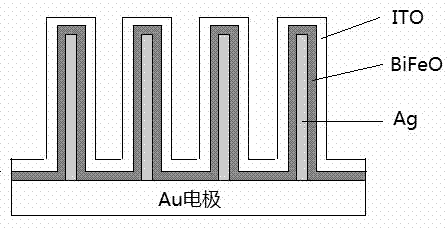Preparation method for bismuth titanate nanowire solar cells
A solar cell, bismuth ferrite nanotechnology, applied in the manufacture of circuits, electrical components, final products, etc.
- Summary
- Abstract
- Description
- Claims
- Application Information
AI Technical Summary
Problems solved by technology
Method used
Image
Examples
specific Embodiment 1
[0029] 1. High-purity Al sheet annealing
[0030] Annealing temperature is 500 0 C, the annealing time is 4 hours, take it out after cooling to room temperature with the furnace.
[0031] 2. ultrasonic cleaning
[0032] Sonicate with acetone, ethanol, and deionized water for 3 minutes in sequence to remove stains on the surface of the Al sheet.
[0033] 3. remove natural oxide layer
[0034] With 2 mol / L NaOH solution, the temperature is 60 0 C, the soaking time is 2 minutes, then take out and rinse with deionized water to remove the natural oxide layer.
[0035] 4. electrochemical polishing
[0036] Put the Al sheet into a mixed solution of 5vol% sulfuric acid, 95vol% phosphoric acid and 20 g / L chromic acid, use a stirring device to circulate the mixed solution, perform electrochemical polishing for 5 minutes, and the temperature of the water bath is 85 0 C, the polishing current is 0.8 A, and then it is taken out and cleaned with deionized water.
[00...
specific Embodiment 2
[0056] The difference between this embodiment and the specific example 1 is that in step 5, the voltage of anodic oxidation is changed to 10 V, 25 V, 60 V, and 100 V respectively, and then the pore sizes are respectively 20 nm, 35 nm, 80 nm, and 120 nm. nm porous alumina template, other steps and parameters are the same as those in Embodiment 1.
[0057] Implementation effect: get BiFeO 3 The optical bandgap of the nanowire is 2.4 eV, at AM 1.5, 100 mW / cm 2 Under the irradiation of standard light intensity, the short-circuit current density is 6-8 mA / cm 2 , the open circuit voltage is 0.8-1 V, and the efficiency is 0.8-1.2%.
specific Embodiment 3
[0059] The difference between this embodiment and the specific example 1 is that in step 7, the double-pass porous alumina template is immersed in 6wt% phosphoric acid to expand the pores for 5-40 minutes, and a double-pass alumina template with a pore size of 60-200 nm can be obtained. Other steps and parameters are the same as those in the first embodiment.
[0060] Implementation effect: get BiFeO 3 The optical bandgap of the nanowire is 2.4 eV, at AM 1.5, 100 mW / cm 2 Under the irradiation of standard light intensity, the short-circuit current density is 6-7 mA / cm 2 , the open circuit voltage is 0.8-0.9 V, and the efficiency is 0.8-1%.
PUM
| Property | Measurement | Unit |
|---|---|---|
| thickness | aaaaa | aaaaa |
| thickness | aaaaa | aaaaa |
Abstract
Description
Claims
Application Information
 Login to View More
Login to View More - R&D
- Intellectual Property
- Life Sciences
- Materials
- Tech Scout
- Unparalleled Data Quality
- Higher Quality Content
- 60% Fewer Hallucinations
Browse by: Latest US Patents, China's latest patents, Technical Efficacy Thesaurus, Application Domain, Technology Topic, Popular Technical Reports.
© 2025 PatSnap. All rights reserved.Legal|Privacy policy|Modern Slavery Act Transparency Statement|Sitemap|About US| Contact US: help@patsnap.com

